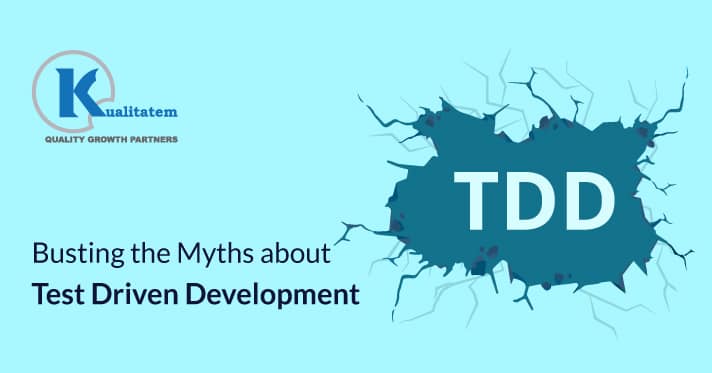Busting The Myths About Test Driven Development!

- May 16, 2018
- Kualitatem
Test Driven Development (TDD) is just another software development process that speeds up the whole development cycle for faster results. The widely adopted software development process involves a series of iterative unit tests that are run on functional code being developed. Each unit test is executed to find out the most functional factor of the source codes.
The idea behind TDD is to accelerate the software development and testing processes, ignoring the fact that the tests fail in the initial stages.
Generally, this flowchart is followed in TDD:
Write a failing test → Pass the test → Refactor and the cycle continues
Every code development cycle undergoes testing that extracts its ability to function according to the data provided and analyses its likelihood to stay retained even after refactoring.
Hence, automated testing is executed repetitively until the testers achieve the anticipated functionality in the source codes.
Although TDD serves as an integrated methodology to effectively complete a software development cycle, there are multiple myths linked with its execution.
Let’s bust these myths and get the truth out of them logically:
TDD is a Time-Sucking Process!
Every software development team aspires to ship a feature-rich product under a fixed time limit and very cost-friendly budget. TDD is a helpful and resourceful process to measure everlasting benefits. Although, including TDD in a complicated project is somehow assumed to botch-up pre-decided deadlines.
But viewing it from the other side of the mirror, we see that TDD implementation actually brings out developer’s productivity and increases the overall project performance.
Basically, it reduces the time constraints by decreasing the rate of defects found during the application deployment phase. All testers agree that later fixing is annoying and time-consuming, which can be smoothly compensated by TDD process. Any issues in the initial production risk the company’s reputation and position in the market.
What? You Write Test Cases Before Code?!!
Since the Agile approach has dived in, developers feel it is challenging to write unit tests according to the product design. But following the advanced iterative model, developers can intuitively create various scenarios that can save the product’s release from any disasters in real-time.
The TDD implementation is a brilliant technique that convinces developers to think in a specific way that eventually leads to the desired product delivery. The early test writing delivers immediate feedback from the iterative unit test execution and adds fluency in the code creation process later. Finally, the end results received are free of bugs in due time.
TDD is a Test Planning Method
Technically and conceptually, TDD is a software design or test planning methodology, however, it helps in creating a perfect design. Generating the code design and function automatically creates a well-designed code that later helps in high-quality test running and releasing processes.
But TDD doesn’t cater the data configurations, design frames, system architecture, scalability, and stability considerations. Though its crucial support in test planning help in managing the other parts of SDLC through the process.
TDD ensures Max Coverage
Well, there’s another myth: IT hubs pursue TDD implementation just to achieve 100% code coverage in the software development process. But little do they know that writing partial or bad-quality tests will not help in achieving their targeted goal. Typically, code coverage is measured only if the executed tests are well-written. Thus, it is just a misconception that TDD ensures 100% code coverage as well as the product sufficiency.
These are plain myths, and now that the truth is out there, it shouldn’t be a problem in adopting TDD. So what’s the wait for?











